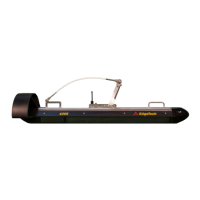3-47
attached from the tow point to the stern of the towfish, will pull the towfish, stern first, over the
obstruction or through the snag.
Both the Single-Pulse (SP) and Multi-Pulse (MP) configurations of the 4205 High Definition Tri-Frequency
Side Scan Sonar System provide simultaneous frequency operation and are designed to accommodate the
integration of optional sensors. All configurations provide excellent signal-to-noise performance, resulting
in superb data, reliably transmitted digitally over coaxial cables up to 6,000m.
3.1.1.1 4205 Tri-Frequency & Single Pulse Towfish
EdgeTech offers a tri-frequency tide Scan Sonar (120/410/850 kHz or 230/540/850 kHz), allowing
surveyors the option to operate any two frequencies simultaneously. Long-range operations can be
achieved with a selection of 120/410 kHz combination and then, on-demand, the 4205 can be changed to
operate at 410/850kHz for a higher resolution survey. Target positioning is improved with the integration
of a more accurate heading sensor that can be coupled with an optional USBL beacon.
The 4205 MPMT Towfish is available in the customer’s choice of 100/400, 230/850 kHz, and 230/540 kHz
operating frequencies. The Towfish includes identical port and starboard transducer arrays, where each
includes high, mid, and low frequency transmit/receive elements.
The towfish electronics include separate transmitters and separate receivers. Received sonar signals are
digitized and transmitted to the topside processor over an ADSL link, using a coax tow cable up to 6000
meters in length — contact CUSTOMER
SERVICE for questions concerning cable type vs. lengths.
Operation is in single pulse (SP) mode, and a maximum towfish speed of 4.8 knots will ensure compliance
with the NOAA and IHO-44S Shallow Water Survey Specification of three pings on a 1-meter cubed target
with the range set at 100 meters.
In Single Pulse, High Definition Mode (HDM), only the forward transducer is used to both transmit and
receive acoustic energy. In this mode, a higher resolution image is obtained at the expense of lower tow
speeds (for full bottom coverage).
3.1.1.2 4205-MPMT Towfish
The 4205-MPMT system enables higher survey speeds while maintaining full-bottom along-track
coverage. The towfish includes identical port and starboard forward-mounted and aft-mounted
transducer arrays. It is available with a choice of 120/410 kHz, 230/540 kHz, or 230/850 kHz dual linear
FM chirp operating frequencies.
The towfish operates in either Multi-Pulse/Motion Tolerant (MP/MT) mode or Single Pulse (High
Definition) mode. In MP/MT mode, the forward transducer array is used as a transmitter, and the aft array
is used as a receiver. The resulting transducer beam pattern shape compensates for motion in the tow
vehicle yaw axis while facilitating high-speed operation by transmitting and receiving multiple pulses in
the water.
Compared to the SP system, the MP configuration allows two pulses to be in the water during each ping
cycle instead of just one. This essentially breaks the sound speed barrier by allowing twice the
conventional survey vessel speeds to be used for the same coverage. At conventional survey speeds, twice

